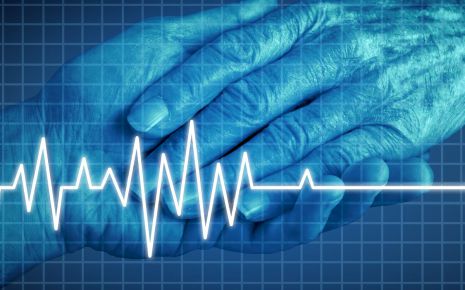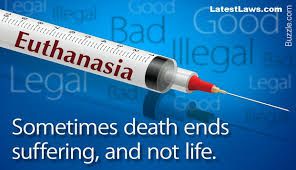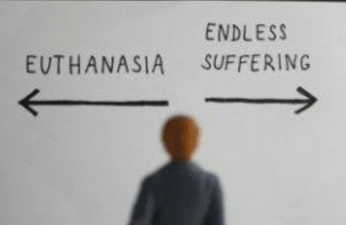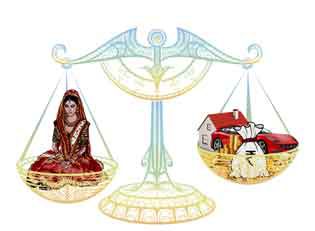End Of Life Choices And Article 21: Legal And Ethical Contours Of Euthanasia
Every single being in this world has a right to life and to live in this
world with dignity. It is the universal right to every human being existing in
this world irrespective of their caste, gender, creed, race and sex. No
individual can deprive of Right to life under any circumstances. Article 3 of
Universal Declaration of Human Rights states that 'Everyone has right to life,
liberty and security of person'. In India, our Constitution also states under
Article 21 that 'No person shall be deprives of his life or personal liberty
except according to procedure established by law'.
The phrase "right to life" would include the right to live with dignity, which would imply that this right would last until the end of natural life. A dying human's right to pass away with dignity may be one of these. However, it is important to distinguish between the "right to die with dignity" and the "right to die" an unnatural death that shortens one's natural life expectancy. There are countries which have made euthanasia legal but India doesn't support euthanasia.
The words 'euthanasia' and 'thantos' which in Ancient Greek indicate 'good death' and death respectively, are the origins of the term. It is the act or practice of ending the life of a person by injection or by ceasing extraordinary medical care in order to relieve him of excruciating pain or from a terminal sickness when they have a terminal illness or an incurable condition.
The term "euthanasia" refers to the deliberate killing of a person whose life is deemed to be unworthy of living. It is sometimes referred to as "Mercy Killing," which is an act where a person who is in an unfixable situation or has no prospect of survival because he is experiencing excruciating pain ends his life in a painless way. It is a painless, easy, and compassionate dying. It's a complex and ethically charged topic that raises significant moral, medical, legal, and social considerations.
Suicide and euthanasia are conceptually distinct from one another. In a suicide, a man intentionally kills himself by poisoning, stabbing, or another method. Without a doubt, suicide refers to a deliberate attempt at suicide. It is an intentional act or event where someone kills themselves, usually out of depression or for other reasons like being unlucky in love, failing an exam, or having trouble finding a good job, among others.
Euthanasia, on the other hand, involves someone else taking action to end the life of a third party. A third party participates in euthanasia either actively or passively, aiding or abeting the death of another. It is significant to note that "assisted suicide" and "euthanasia" are not the same thing in this context. A person who actively aids another person in committing suicide, such as by giving him the means to do so, is said to be engaging in assisted suicide. It is referred to as "physician assisted suicide" when a doctor gives a patient a prescription for a lethal drug to help them kill themselves.
Since the patient commits the act of suicide, he or she has entire control over the steps leading to death in an aided suicide. The other person only lends a hand, such as by giving the necessary tools to complete the action. On the other hand, euthanasia can be active, like when a doctor gives a patient a lethal injection, or passive, like when a doctor turns off the patient's life support system.
Euthanasia legislation varies greatly from country to country. Some nations, including the Netherlands, Belgium, and Canada, have made some types of euthanasia lawful in certain circumstances. It continues to be outlawed in other places. The issue raises complex questions about autonomy, medical ethics, religious beliefs, and the government's role in setting boundaries for individual freedom and medical assistance. In India, euthanasia, commonly referred to as "mercy killing" or "assisted dying," has been the focus of legal and ethical discussion. The distinction between passive and active euthanasia was crucial to the legal framework around euthanasia in India.
In P Rathinam v. Union of India [i], the court dismissed the argument that "euthanasia (mercy killing) should be permitted by law and held-The Court would not decide this point as it is outside the purview of the present petition and secondly because in euthanasia a third person is either actively passively involved about whom it may be said that he aids or abets the killing of another person. There is a difference between a person's attempt to terminate his life and another person being killed by someone else; this distinction can be drawn on principle and is logically acceptable.
In the case of Aruna Ramchandra Shanbaug v. Union of India[ii] that directed that passive euthanasia will be made legal under exceptional circumstances with strict monitoring without any legislation provided a significant boost to the legalization of passive euthanasia. Following are the guidelines provided by the Supreme Court for approving passive euthanasia: The decision to stop giving life support must be made by parents, spouses, other close relatives, or, in the absence of any of them, a person or group of individuals acting in the position of a next friend
It may be taken by the medical staff treating the patient. However, the patient's best interests must really guide the decision-making process. The High Court must give its approval even if the decision to stop life support was reached by intimate friends, family members, or medical professionals[iii].
In the case of Common Cause (A Regd. Society) v. Union of India[iv], Common Cause filed a petition with the Supreme Court under Article 32, asking the court to rule that the right to pass away with dignity is a fundamental human right protected by Article 21. Common Cause also asked the court to order the Union Government to permit terminally ill people to execute "living wills" to specify what should be done if they were admitted to hospitals.
People with fatal illnesses or those who have ongoing medical conditions shouldn't be treated inhumanely, according to Common Cause. Their agony will be prolonged if their right to a peaceful death is denied. It pleaded with the Court to safeguard these people's right to pass away with dignity by providing them with the chance to make an educated decision through a living will.
"A person in a persistent vegetative state may choose passive euthanasia, and that person can execute a living will to refuse medical treatment in the event of a lethal illness that can't be cured," the Apex Court ruled. The court also published comprehensive rules on the procedure for carrying out passive euthanasia and advance directive execution in response to worries about the abuse of advance directives (or living wills), such as those voiced by the Law Commission of India in its 241st Report.
The recommendations will be in effect up until Parliament passes a law on the subject. The findings of the present study indicate that the debate over euthanasia covers fundamental, major, and doctrinal opinions in addition to the topic of suicide.
In conclusion, discussing euthanasia, it was important to strike a careful balance between upholding a person's autonomy and moral obligations to protect the sanctity of life. The conversation around euthanasia in India was influenced by public opinion, medical ethics, religious convictions, and legal viewpoints. In addition to discussing legal issues, the discussion also covered intellectual, ethical, and moral issues. With continued discussions over the rights of those experiencing excruciating suffering and the moral obligations of medical professionals and society at and society at large, euthanasia in India remains complex and developing issue.
End-Notes:
The phrase "right to life" would include the right to live with dignity, which would imply that this right would last until the end of natural life. A dying human's right to pass away with dignity may be one of these. However, it is important to distinguish between the "right to die with dignity" and the "right to die" an unnatural death that shortens one's natural life expectancy. There are countries which have made euthanasia legal but India doesn't support euthanasia.
The words 'euthanasia' and 'thantos' which in Ancient Greek indicate 'good death' and death respectively, are the origins of the term. It is the act or practice of ending the life of a person by injection or by ceasing extraordinary medical care in order to relieve him of excruciating pain or from a terminal sickness when they have a terminal illness or an incurable condition.
The term "euthanasia" refers to the deliberate killing of a person whose life is deemed to be unworthy of living. It is sometimes referred to as "Mercy Killing," which is an act where a person who is in an unfixable situation or has no prospect of survival because he is experiencing excruciating pain ends his life in a painless way. It is a painless, easy, and compassionate dying. It's a complex and ethically charged topic that raises significant moral, medical, legal, and social considerations.
Euthanasia can be categorized into several types:
- Voluntary Euthanasia: This occurs when a person explicitly requests or consents to end their life due to their own suffering. The decision is made by the individual, and a physician or another party may assist in carrying out the act.
- Non-voluntary Euthanasia: In cases where the individual is unable to make a decision, either due to unconsciousness, severe cognitive impairment, or being a minor, someone else makes the decision on their behalf. This form of euthanasia is more controversial, as it involves deciding when it is appropriate to end a life without the explicit consent of the person.
- Involuntary Euthanasia: This type involves ending a person's life against their will, often without their knowledge or consent. It is generally considered unethical and illegal.
- Active Euthanasia: In active euthanasia, a person's life is intentionally ended through a direct action, such as administering a lethal dose of medication.
- Passive Euthanasia: Passive euthanasia involves withholding or withdrawing medical treatment or life-sustaining interventions, allowing the person to die naturally. This can include removing life support or not initiating certain treatments.
- Assisted Suicide: In assisted suicide, a person provides the means for another individual to end their own life. This might involve providing them with a lethal dose of medication that they can self-administer.
Suicide and euthanasia are conceptually distinct from one another. In a suicide, a man intentionally kills himself by poisoning, stabbing, or another method. Without a doubt, suicide refers to a deliberate attempt at suicide. It is an intentional act or event where someone kills themselves, usually out of depression or for other reasons like being unlucky in love, failing an exam, or having trouble finding a good job, among others.
Euthanasia, on the other hand, involves someone else taking action to end the life of a third party. A third party participates in euthanasia either actively or passively, aiding or abeting the death of another. It is significant to note that "assisted suicide" and "euthanasia" are not the same thing in this context. A person who actively aids another person in committing suicide, such as by giving him the means to do so, is said to be engaging in assisted suicide. It is referred to as "physician assisted suicide" when a doctor gives a patient a prescription for a lethal drug to help them kill themselves.
Since the patient commits the act of suicide, he or she has entire control over the steps leading to death in an aided suicide. The other person only lends a hand, such as by giving the necessary tools to complete the action. On the other hand, euthanasia can be active, like when a doctor gives a patient a lethal injection, or passive, like when a doctor turns off the patient's life support system.
Euthanasia legislation varies greatly from country to country. Some nations, including the Netherlands, Belgium, and Canada, have made some types of euthanasia lawful in certain circumstances. It continues to be outlawed in other places. The issue raises complex questions about autonomy, medical ethics, religious beliefs, and the government's role in setting boundaries for individual freedom and medical assistance. In India, euthanasia, commonly referred to as "mercy killing" or "assisted dying," has been the focus of legal and ethical discussion. The distinction between passive and active euthanasia was crucial to the legal framework around euthanasia in India.
In P Rathinam v. Union of India [i], the court dismissed the argument that "euthanasia (mercy killing) should be permitted by law and held-The Court would not decide this point as it is outside the purview of the present petition and secondly because in euthanasia a third person is either actively passively involved about whom it may be said that he aids or abets the killing of another person. There is a difference between a person's attempt to terminate his life and another person being killed by someone else; this distinction can be drawn on principle and is logically acceptable.
In the case of Aruna Ramchandra Shanbaug v. Union of India[ii] that directed that passive euthanasia will be made legal under exceptional circumstances with strict monitoring without any legislation provided a significant boost to the legalization of passive euthanasia. Following are the guidelines provided by the Supreme Court for approving passive euthanasia: The decision to stop giving life support must be made by parents, spouses, other close relatives, or, in the absence of any of them, a person or group of individuals acting in the position of a next friend
It may be taken by the medical staff treating the patient. However, the patient's best interests must really guide the decision-making process. The High Court must give its approval even if the decision to stop life support was reached by intimate friends, family members, or medical professionals[iii].
In the case of Common Cause (A Regd. Society) v. Union of India[iv], Common Cause filed a petition with the Supreme Court under Article 32, asking the court to rule that the right to pass away with dignity is a fundamental human right protected by Article 21. Common Cause also asked the court to order the Union Government to permit terminally ill people to execute "living wills" to specify what should be done if they were admitted to hospitals.
People with fatal illnesses or those who have ongoing medical conditions shouldn't be treated inhumanely, according to Common Cause. Their agony will be prolonged if their right to a peaceful death is denied. It pleaded with the Court to safeguard these people's right to pass away with dignity by providing them with the chance to make an educated decision through a living will.
"A person in a persistent vegetative state may choose passive euthanasia, and that person can execute a living will to refuse medical treatment in the event of a lethal illness that can't be cured," the Apex Court ruled. The court also published comprehensive rules on the procedure for carrying out passive euthanasia and advance directive execution in response to worries about the abuse of advance directives (or living wills), such as those voiced by the Law Commission of India in its 241st Report.
The recommendations will be in effect up until Parliament passes a law on the subject. The findings of the present study indicate that the debate over euthanasia covers fundamental, major, and doctrinal opinions in addition to the topic of suicide.
In conclusion, discussing euthanasia, it was important to strike a careful balance between upholding a person's autonomy and moral obligations to protect the sanctity of life. The conversation around euthanasia in India was influenced by public opinion, medical ethics, religious convictions, and legal viewpoints. In addition to discussing legal issues, the discussion also covered intellectual, ethical, and moral issues. With continued discussions over the rights of those experiencing excruciating suffering and the moral obligations of medical professionals and society at and society at large, euthanasia in India remains complex and developing issue.
End-Notes:
- (1996) 2 SCC 648
- AIR 2011 SC 1290
- Constitutional Law of India by Dr. JN Pandey
- AIR 2018 SC 1665
Law Article in India
Legal Question & Answers
Lawyers in India - Search By City
LawArticles
How To File For Mutual Divorce In Delhi

How To File For Mutual Divorce In Delhi Mutual Consent Divorce is the Simplest Way to Obtain a D...
Increased Age For Girls Marriage

It is hoped that the Prohibition of Child Marriage (Amendment) Bill, 2021, which intends to inc...
Facade of Social Media

One may very easily get absorbed in the lives of others as one scrolls through a Facebook news ...
Section 482 CrPc - Quashing Of FIR: Guid...

The Inherent power under Section 482 in The Code Of Criminal Procedure, 1973 (37th Chapter of t...
The Uniform Civil Code (UCC) in India: A...

The Uniform Civil Code (UCC) is a concept that proposes the unification of personal laws across...
Role Of Artificial Intelligence In Legal...

Artificial intelligence (AI) is revolutionizing various sectors of the economy, and the legal i...








Please Drop Your Comments